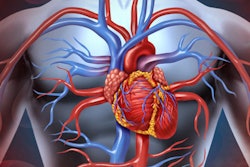
The CT perfusion scans of patients with pancreatic cancer revealed that those who responded well to chemoradiation therapy had higher blood flow measurements both before and after treatment than did patients who responded poorly in a new study, published online July 9 in Radiology.
It is becoming increasingly evident that evaluating a patient's response to therapy using conventional CT is insufficient, especially for thick, fibrous cancers such as pancreatic ductal adenocarcinoma, noted lead author Dr. Ahmed Hamdy from Mie University Hospital in Japan and colleagues.
Recent research has demonstrated that more advanced modalities such as PET/CT, PET/MRI, and perfusion imaging are better equipped to stage cancer and determine a patient's response to chemoradiation therapy, the authors continued.
Focusing on the potential of CT perfusion to that end, Hamdy and colleagues examined 21 patients with pancreatic cancer who underwent CT perfusion before and after receiving chemoradiation therapy between June 2016 and May 2018. The average effective radiation dose used for the CT perfusion exams was 12.8 mSv before treatment and 11.3 mSv after treatment.
The baseline blood flow -- but not blood volume or permeability surface area product (PSP) -- was greater by a statistically significant degree in patients who responded positively to chemoradiation therapy, compared with those who did not respond to treatment (p < 0.04), the researchers found. They recommended a cutoff point of 32 mL/100 g/min in a patient as the lowest degree of blood flow indicating a positive response to treatment.
After chemoradiation therapy, the blood flow and blood volume increased in all the patients, but the increases were only statistically significant for those who responded positively to treatment.
| Association between CT perfusion measurements and response to chemoradiation | ||||
| Patients who did not respond to treatment | Patients who responded positively to treatment | |||
| Before treatment | After treatment | Before treatment | After treatment | |
| Blood flow (mL/100 g/min)* | 33 | 43 | 44 | 54 |
| Blood volume (mL/100 g)* | 2.8 | 4.8 | 4.3 | 6.8 |
| PSP (mL/100 g/min) | 20 | 28 | 26 | 32 |
These findings differ from the results of most studies that have used CT perfusion to assess tumor response to cancer treatment, Dr. Valentin Sinitsyn, PhD, from Moscow State University in Russia noted in an accompanying editorial. Whereas prior research has shown declines in blood flow, blood volume, or PSP after chemoradiation therapy for certain types of cancer, Hamdy and colleagues are reporting greater increases in tissue perfusion for pancreatic cancer patients who responded to treatment, compared with those who did not.
The researchers offered several possible explanations for this divergence. First, pancreatic ductal adenocarcinomas often have an especially dense extracellular matrix that, when less prominent in some individuals, allows for greater blood flow through tumors and, thus, a better response to chemoradiation. Second, chemoradiation therapy for pancreatic cancer may help mitigate the production of fibrous tissue in tumors, which then frees up blood vessels to deliver chemoradiation more effectively.
"In general, this small but essential study supports the idea of using perfusion CT for the selection of patients who will benefit most from chemoradiation therapy ... [showing] us a new direction for perfusion CT for patients with cancer," Sinitsyn wrote.



















